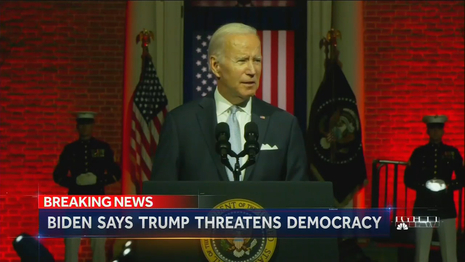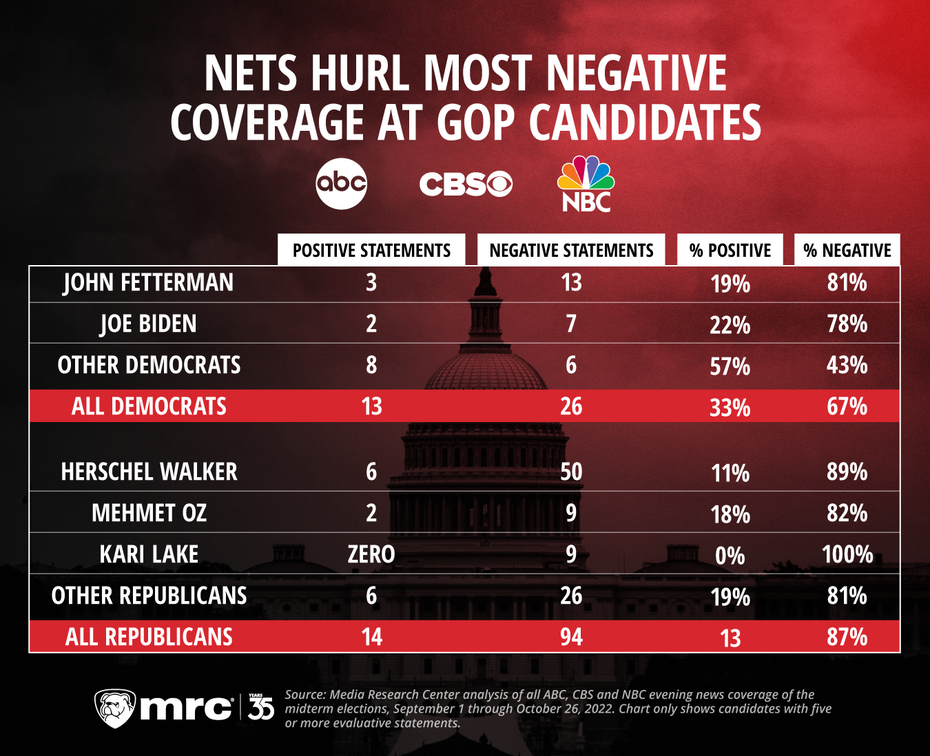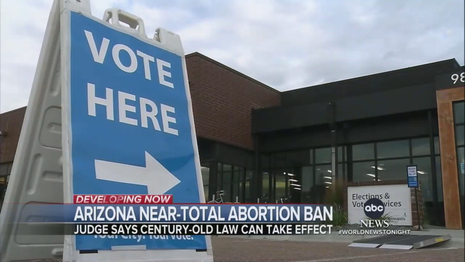Four years ago, TV’s midterm coverage hammered Republican candidates and then-President Trump with 88 percent negative spin while sparing Democrats similarly bad press. This year, Democrats are in charge of the White House and both chambers of Congress, yet a new Media Research Center study of ABC, CBS and NBC evening newscasts finds that Republicans are receiving coverage that is just as negative (87% negative) as in 2018, while Democrats — including the President — are drawing far less scrutiny than the party out of power.
And another favor for Team Blue: the dominant topics within these campaign stories — GOP candidate controversies, abortion rights and the danger of “election deniers” — perfectly match the topmost items in Democrats’ campaign playbook. Our study shows discussion of these issues within campaign stories far eclipsed that of the economy and inflation, issues that voters deem most important.
This year’s study looked at the same period of time as we did in 2018, from September 1 to October 26. This year, the Big Three evening newscasts aired 115 stories which mentioned or discussed the midterm elections during, with a total airtime of 213 minutes, or about 60 percent more than the 130 minutes we tallied four years ago.
Key findings:
 ■ Burying Biden: While President Trump was a huge focus of network coverage four years ago (accounting for 48% all midterm campaign airtime in 2018, more than all of the individual House, Senate and gubernatorial candidates combined), the networks aren’t interested in targeting President Biden this year. Biden accounted for just 34 minutes of midterm coverage, just 16 percent of total campaign coverage. (See note below.)
■ Burying Biden: While President Trump was a huge focus of network coverage four years ago (accounting for 48% all midterm campaign airtime in 2018, more than all of the individual House, Senate and gubernatorial candidates combined), the networks aren’t interested in targeting President Biden this year. Biden accounted for just 34 minutes of midterm coverage, just 16 percent of total campaign coverage. (See note below.)
And there’s virtually no debate about the successes or failures of the Biden presidency, as one would normally expect. TV’s 2022 campaign stories included just nine evaluative comments about President Biden (two positive, seven negative, or 78% negative spin. See the full methodology at the bottom of this article.) Four years ago, these same networks aired seven times as many evaluative comments about President Trump (9 positive vs. 54 negative, or 86% negative spin).
Despite the fevered TV coverage four years ago, the public gave Trump slightly higher marks going into the midterms. As of October 26, the RealClearPolitics average shows only 43 percent of Americans approve of Biden’s job approval, vs. 54 percent who disapprove. Exactly four years earlier, Trump’s approval rating was 44 percent vs. 52 percent disapproval. Yet despite the public’s disapproval, the networks aren’t giving Biden the ferocious negative attention they heaped on Trump four years ago.
■ Blasting Republicans: Overall this fall, Democrats (including President Biden) drew 13 positive comments vs. 26 negative ones, for a 67% negative spin. That’s not great, but not nearly as bad as Republicans, who were slammed with 94 negative comments vs. 14 positive statements, a spin score of 87 percent negative — and virtually identical to the 88 percent negative spin for the whole GOP (including Trump) in 2018.
Most of this year’s discussion centered on four candidates: Republicans Herschel Walker, Mehmet Oz and Kari Lake, and Democrat John Fetterman. Fetterman’s bad press (81% negative, mostly comments panning his dreadful debate performance) was the worst of any Democrat, but it was better than any of the top Republicans. His Senate rival, Oz, was hit with 82 percent negative press, while Georgia’s Herschel Walker was slammed with 50 negative statements vs. six positive ones, an 89 percent negative spin.

That’s still better than Arizona’s Kari Lake, who was on the receiving end of nine evaluative comments, all negative, giving her a 100 percent negative press score.
While no Democratic candidate other than Fetterman received heavy coverage, there were occasional positive features for several of them, contributing to the Democrats’ more positive press. Alaska House candidate Mary Peltola, for example, was profiled in a glowing September 24 CBS Evening News story about her “milestone” status as the first native Alaskan in Congress.
 Three days earlier, NBC’s Blayne Alexander gifted Georgia Democrat Stacey Abrams with a “Power of the Vote” profile about her efforts to turn out “hundreds of thousands of new voters” in her re-match with Republican Governor Brian Kemp. Suffice it to say, no Republican candidate received such a treat from any of these newscasts this cycle.
Three days earlier, NBC’s Blayne Alexander gifted Georgia Democrat Stacey Abrams with a “Power of the Vote” profile about her efforts to turn out “hundreds of thousands of new voters” in her re-match with Republican Governor Brian Kemp. Suffice it to say, no Republican candidate received such a treat from any of these newscasts this cycle.
■ Showcasing Democrats’ Agenda: While voters consistently ranked the economy and inflation as the most important issues this fall, the broadcast networks’ campaign coverage instead emphasized the agenda favored by Democratic consultants. Thus, the economy was only the fifth-most cited issue within these midterm stories, with 15 minutes of airtime. That’s barely half of what was spent on anonymous and unverified allegations that GOP candidate Herschel Walker years ago paid for two women’s abortions, charges that Walker vehemently denied.

Separately, the networks spent nearly 24 minutes on abortion policy, apparently believing the premise that the Supreme Court’s overturning of Roe v. Wade would rally the liberal base. “Most Democrats say the overturning of Roe has made them more likely to vote,” CBS’s Robert Costa announced on September 14.
 Eleven days later, ABC’s MaryAlice Parks touted her own network’s poll as good news for pro-abortion candidates, with “Americans trusting Democrats by a 20-point margin on the issue.”
Eleven days later, ABC’s MaryAlice Parks touted her own network’s poll as good news for pro-abortion candidates, with “Americans trusting Democrats by a 20-point margin on the issue.”
Combined with the abortion-related allegations against Walker, abortion was the focus of 54 minutes of airtime, or about one-fourth of all midterm news. Yet a September Gallup poll found only four percent of voters named abortion as the “most important problem” facing the country, vs. 38 percent who named an economic issue.
Rounding out the networks’ top three campaign issues, with 21 minutes of airtime: the alleged peril to democracy in the wake of January 6, and the presence of “election deniers” on the ballot. That same Gallup poll found only four percent of voters named “election/election reform/democracy” as the country's biggest problem.
Invariably, the only “election deniers” discussed in these evening news reporters were Republicans; Democrats, such as Georgia’s Stacey Abrams, who denied her loss in 2018, were never so labeled.
+++++++++++
Viewers and voters seeking election news have more choices than ever, but even today, the Big Three remain uniquely powerful, with relatively large audiences (collectively, about 20 million viewers per night) of citizens who are not as ideologically-established as the fans of wall-to-wall cable news.
So while the establishment media fret about dangers to democracy, there’s a danger in a powerful partisan media passing itself off as objective or centrist, when the reality is that the networks are now open advocates for the success of one party over the other.
Note: Be aware that all figures for airtime and percentages are limited to our examination of midterm campaign coverage. When President Biden was covered in non-campaign contexts, that coverage would not be included here. Similarly, coverage of issues such as the economy, or January 6th, etc., would also not be included unless there was a specific reference to the midterm election. This was the same approach we took in tallying President Trump's airtime within midterm campaign stories in 2018.
METHODOLOGY: We calculated spin by tallying all clearly positive and negative statements from non-partisan sources (in other words, reporters, anchors, voters and other unaffiliated sources). This excludes coverage that merely reflects the partisan back-and-forth of the campaign, in order to isolate the spin being imparted by the networks themselves. It also excludes “horse race assessments” about the candidates’ or a party’s prospects for winning or losing. This is identical to the methodology we used in 2018, to enable direct comparisons between the coverage of both midterms.




